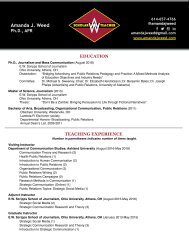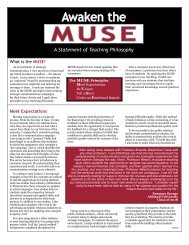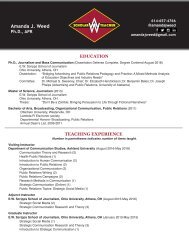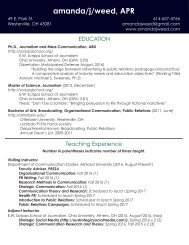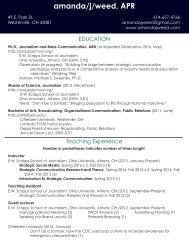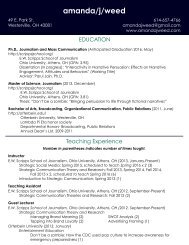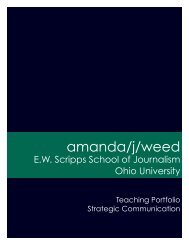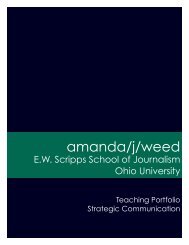Weed_TeachingPhilosophy_2018
Create successful ePaper yourself
Turn your PDF publications into a flip-book with our unique Google optimized e-Paper software.
Be Unique<br />
Allowing students to be co-collaborators<br />
in the learning process is one way I create<br />
a unique learning environment. I often ask<br />
for students’ input in classroom discussion<br />
but, more importantly, to provide feedback<br />
to their peers. Throughout the semester, I<br />
have students participate in team pitches<br />
called “Quickfire Challenges.” In those<br />
challenges, students have 48 hours to<br />
develop a campaign idea for their client and<br />
make a pitch to the class. At the end of the<br />
pitches, students provide feedback to the<br />
teams and vote for their Top Pitch (which<br />
comes with a small prize and bragging<br />
rights). The Quickfire Challenges provide<br />
students with experience in creative<br />
brainstorming and development of criticial<br />
analysis skills, and are often cited as a<br />
favorite assignment.<br />
The second way I create a unique<br />
learning experience is through<br />
“crowdsourced” learning. In Strategic Social<br />
Media, students are contributors to a class<br />
blog, which acts as a showcase for their<br />
work. Assignments are posted so students<br />
may share their work with peers, but<br />
also to promote that work to an audience<br />
outside of the university. The blog provides<br />
hands-on experience for students to apply<br />
their class knowledge, with outcomes that<br />
have direct benefit to their future careers.<br />
Since the beginning of the blog in Spring<br />
2015, students have earned nearly 35,000<br />
views and has been cited by several online<br />
publications including AdWeek, Inc., and<br />
Cracked. The blog has become a valuable<br />
portfolio resource that students may utilize<br />
when applying for internships or jobs.<br />
Finally, I encourage my students to<br />
provide their input for assignments as the<br />
semester progresses. One example of this<br />
is with social media promotion of the class<br />
blog. In the last phase of the blog campaign,<br />
students submit short proposals for<br />
campaign posts and I select the ideas that<br />
best incorporate the concepts learned in<br />
class. By allowing students to have a hand<br />
in designing the campaign, they experience<br />
a heightened sense of ownership for its<br />
outcomes.<br />
I believe that a variety of learning<br />
methods helps students retain and recall<br />
information. As part of my teaching<br />
method, I utilize readings, lectures, class<br />
discussion, and multimedia examples<br />
to reinforce key concepts of the class. I<br />
challenge my students to go beyond recall of<br />
information to critically evaluate examples<br />
from the advertising and public relations<br />
industries. Each semester, I select a core<br />
group of classic campaigns, as well as<br />
current examples. I also encourage students<br />
to share examples of campaigns that they<br />
feel are relevant to our key concepts.<br />
Encouraging their involvement allows<br />
my students to think about our learning<br />
objectives in a context they feel is personally<br />
relevant.<br />
Creating stories are also ways in which<br />
students can exhibit their learning of class<br />
concepts. When students are describing<br />
their consumers and client in the creative<br />
brief, I explain that I want them to tell me<br />
a “research story.” To help them bring their<br />
research story to life, I have developed<br />
assignments encourage them to think about<br />
Strategic communication campaigns<br />
often tap into the emotions of consumers<br />
to draw interest to the strategic message.<br />
The consumer often doesn’t have automatic<br />
recall of a strategic message based because<br />
the words but, instead, emotions are<br />
the trigger to message recall. I use a<br />
comparable model when teaching students<br />
new learning concepts. When I choose<br />
examples of campaigns to reinforce lecture<br />
topics, I often select examples that use<br />
emotional undertones to reach students.<br />
When we discuss the examples, I begin<br />
by asking their emotional response, and<br />
then move to the analysis of the message.<br />
I find this method helps students to recall<br />
information with greater ease and to put it<br />
into a context that has tangible applications.<br />
Tell a Story<br />
their consumers and clients as unique<br />
people who are engaged in a relationship.<br />
One assignment that helps students<br />
create a research story is the brand<br />
personal ad. Students create a personal<br />
ad written from the perspective of their<br />
client who is looking for a “date” with their<br />
desired consumer. I encourage students<br />
to be creative in writing the personal and,<br />
most of all, to have fun with it. I have<br />
found the assignment allows students to<br />
envision their clients and consumers as<br />
actual people having a conversation, which<br />
helps immensely in the brainstorming<br />
and development phase of their strategic<br />
communication campaign.<br />
Finally, I encourage students to find<br />
their personal story promote as a young<br />
professional. I have been the event planner<br />
for “Building Brand You,” now in its fourth<br />
year. “Building Brand You” teaches students<br />
how to begin building a personal brand to<br />
set themselves apart from the competition<br />
when applying for internships and jobs.<br />
Each year, the event grew in popularity to<br />
eventually becoma a college-wide event.<br />
Create an Emotional Impact<br />
To support the learning process, I temper<br />
my constructive feedback with positive<br />
reinforcement. Many talents do not come<br />
naturally, but must be nurtured to reach its<br />
full potential. By sharing my enthusiasm<br />
for the potential in their work, I believe<br />
my students will view crtique as a postive<br />
learning experience.<br />
And finally, I share my passion and<br />
excitement about current topics in the<br />
advertising and public relations industries.<br />
I am a self-proclaimed “brand geek,” which<br />
I embrance in my teaching persona. I have<br />
found that sharing my own enthusiam for<br />
current topics and issues, students are more<br />
likely to bring their own insights into the<br />
discussion and have fun in the learning<br />
process.<br />
Amanda <strong>Weed</strong> with members of the<br />
Ashland University Chapter of PRSSA<br />
Scholar<br />
W A<br />
Teacher<br />
Amanda J. <strong>Weed</strong><br />
Ph.D., APR<br />
614-657-4766<br />
@amandajweed<br />
amandajweed@gmail.com



